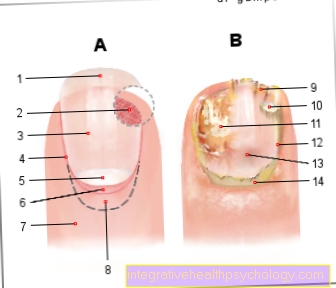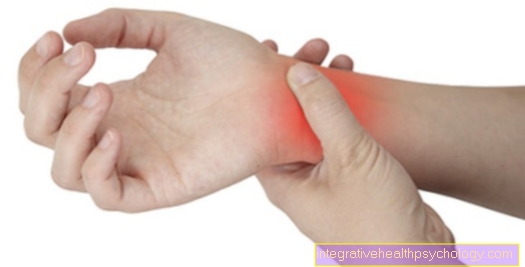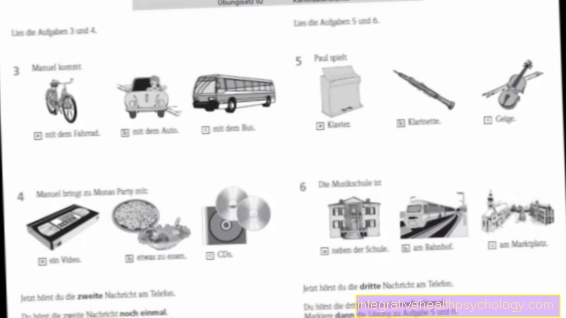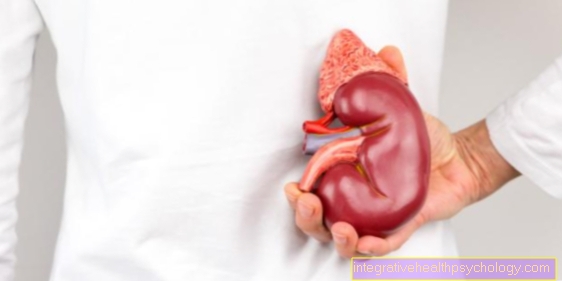Boils on the lip
definition
A lip furuncle is a collection of pus located on the lip in a hair follicle. It is a bacterial inflammation. A boil on the lip appears as a reddened, tender, overheated and hard lump on the lip. The neighboring tissue is often also affected. If several boils merge on the lip, a so-called carbuncle is created. If a lip furunculus occurs again and again, it is referred to in technical jargon as a furunculosis. A boil on the lip can appear spontaneously and without a directly identifiable cause. But it can also arise in the context of other diseases.

Causes of a boil on the lip
A boil on the lip is most often caused by staphylococci. These belong to the normal skin flora. In certain circumstances, they can cause bacterial inflammation and, for example, imply the development of a lip furrow. Small injuries to the lip allow the bacteria to penetrate the skin of the lips along a hair follicle. Once there, a deep inflammatory infiltration develops within a few hours to days.
An uncomplicated lip furuncle usually bursts on its own after about a week. Then the pus can drain and the lip furuncles can be relieved. Then it heals on its own. A small scar remains. The skin of the lips is exposed to chemical, mechanical and physical noxae and stimuli. This can be, for example, cosmetics, drinks that are too hot, sunlight or dust and much more. This can quickly lead to small damage to the skin of the lips. The risk of developing a bacterial infection in the form of a boil, for example, is higher in the case of a weakened body's own immune system, iron deficiency anemia and diabetes mellitus.
You can find out about other causes of a boil on the lip at: Causes of a boil
Diagnosis of a boil on the lip
In order to find out the cause of a lip furuncle, questioning the patient is essential. A lip furuncle is usually a visual diagnosis. The characteristic signs of inflammation are usually present. Sometimes the pus plug appears in the middle as a white-yellowish area. A pathogen detection is particularly necessary in the case of pronounced or recurring boils and accompanying symptoms such as fever. In the case of recurring lip furuncles, the causal disease must be found. Further examinations are often necessary for this. For example, blood sugar is measured and a blood sample is taken in order to control certain parameters in the blood.
The next article explains everything about the sugar test in detail: Test strips for blood sugar
These symptoms have a boil on the lip
A lip furuncle can cause redness, pain, swelling and overheating. If necessary, the pain can radiate. The pain can range from slight tension pain to very severe pain when pressure or the slightest touch. If the boil pops open, pus may evacuate. This can smell unpleasant.
In addition, eating and drinking can be very painful and therefore restricted. More severe cases can lead to exhaustion, a general feeling of illness, flu-like symptoms, chills and fever. If a fever occurs, there is a risk of blood poisoning. If signs of blood poisoning, such as fever, arise, a doctor should be consulted immediately. As a rule, lip furuncles are uncomplicated if the doctor's instructions are followed. However, when complications arise, they are expressed in certain complaints. In these cases, action must be taken quickly. If drowsiness, shock or circulatory failure occur, an emergency doctor must be contacted immediately
Above the lip
A boil above the lip can develop due to an injury when shaving a mustache and the subsequent entry of bacteria. If a lip furuncle is located above the lip, there is a risk of developing septic cavernous sinus thrombosis. This means that the bacteria can get into the brain via the venous blood conductors and lead to an occlusion there. This can have serious consequences. Various neurological disorders can occur, which can be irreversible. In some cases, cavernous sinus thrombosis can be fatal.
Below the lip
A boil can also develop below the lip. Shaving the beard can cause minor injuries below the lip. After that, it is possible for bacteria to enter and a lip furuncle develops below the lip. Heavy beard growth can delay healing.
Treatment of a boil on the lip
The treatment of lip furuncles depends on the size and individual factors. In any case, you shouldn't try to express the boil on your own. If possible, it should not be touched at all. Adequate hygiene is the basis for treating lip furuncle. At best, the lip is exposed to as little chemical, mechanical or physical stimuli or noxa as possible. Warm compresses and moist heat can help drain the pus and thus relieve a mature boil.
If the pus does not come out of its own accord after a while, minor surgery may be necessary. Furthermore, antibiotic and antiseptic lip ointments are often required for wound healing. If the bacteria have entered the blood or lymphatic system, treatment with antibiotics in the form of tablets must be carried out for at least a week. With recurring lip furuncle, the underlying diseases must be treated. Treatment with rifampicin and clindamycin for 2-3 weeks may also be indicated here. If there is an immune deficiency, among other things, the administration of vitamin C may be advisable. In the case of boils on the face, absolute bed rest and a soft diet are also indicated.
Read more about the treatment of a boil at: Treatment of a boil
Duration of healing from a lip furuncle
The healing time of a lip furuncle depends on the size, the strength of the body's own defense system and individual influences. Small lip furuncles can heal within a few days. The stronger the immune system, the faster healing occurs. Furthermore, conscientious hygiene can contribute to a faster healing process. If the immune system is weakened and the lip cannot be adequately protected from dust, dirt and stress, wound healing can be delayed. In some cases, healing can take weeks to months.
Are you interested in this topic? Read more about this under: Duration of a boil





























